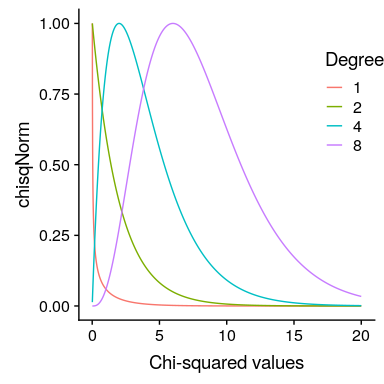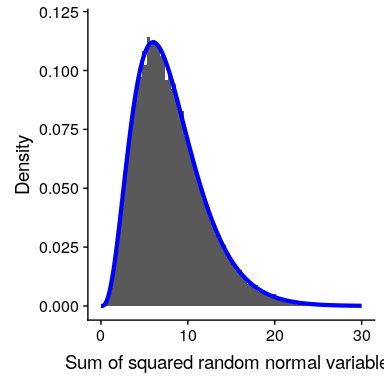## 12.2 皮爾遜卡方檢驗
皮爾遜卡方檢驗為我們提供了一種方法來檢驗觀察到的計數數據是否與定義零假設的某些特定預期值不同:

在我們的糖果例子中,無效假設是每種糖果的比例是相等的。我們可以計算我們觀察到的糖果計數的卡方統計,如下所示:
```r
# compute chi-squared statistic
nullExpectation <- c(1 / 3, 1 / 3, 1 / 3) * sum(candyDf$count)
chisqVal <-
sum(
((candyDf$count - nullExpectation)**2) / nullExpectation
)
```
這個分析的卡方統計結果是 0.74,這本身是不可解釋的,因為它取決于加在一起的不同值的數量。然而,我們可以利用這樣一個事實:卡方統計量是根據零假設下的特定分布分布分布的,這就是所謂的 _ 卡方 _ 分布。這種分布被定義為一組標準正態隨機變量的平方和;它有若干自由度,等于被加在一起的變量數。分布的形狀取決于自由度的數量。圖[12.1](#fig:chisqDist)顯示了幾種不同自由度的分布示例。

圖 12.1 不同自由度的卡方分布示例。
讓我們通過模擬來驗證卡方分布是否準確地描述了一組標準正態隨機變量的平方和。
```r
# simulate 50,000 sums of 8 standard normal random variables and compare
# to theoretical chi-squared distribution
# create a matrix with 50k columns of 8 rows of squared normal random variables
d <- replicate(50000, rnorm(n = 8, mean = 0, sd = 1)**2)
# sum each column of 8 variables
dMean <- apply(d, 2, sum)
# create a data frame of the theoretical chi-square distribution
# with 8 degrees of freedom
csDf <-
data.frame(x = seq(0.01, 30, 0.01)) %>%
mutate(chisq = dchisq(x, 8))
```
圖[12.2](#fig:chisqSim)顯示,理論分布與重復將一組隨機正態變量的平方相加的模擬結果非常吻合。

圖 12.2 平方隨機正態變量和的模擬。柱狀圖是基于 5 萬組 8 個隨機正態變量的平方和;藍線顯示了 8 個自由度下理論卡方分布的值。
對于糖果的例子,我們可以計算在所有糖果的相同頻率的零假設下,我們觀察到的卡方值為 0.74 的可能性。我們使用自由度等于 k-1(其中 k=類別數)的卡方分布,因為我們在計算平均值以生成預期值時失去了一個自由度。
```r
pval <- pchisq(chisqVal, df = 2, lower.tail = FALSE) #df = degrees of freedom
sprintf("p-value = %0.3f", pval)
```
```r
## [1] "p-value = 0.691"
```
這表明,觀察到的糖果數量并不是特別令人驚訝的,基于印刷在糖果袋上的比例,我們不會拒絕等比的無效假設。
- 前言
- 0.1 本書為什么存在?
- 0.2 你不是統計學家-我們為什么要聽你的?
- 0.3 為什么是 R?
- 0.4 數據的黃金時代
- 0.5 開源書籍
- 0.6 確認
- 1 引言
- 1.1 什么是統計思維?
- 1.2 統計數據能為我們做什么?
- 1.3 統計學的基本概念
- 1.4 因果關系與統計
- 1.5 閱讀建議
- 2 處理數據
- 2.1 什么是數據?
- 2.2 測量尺度
- 2.3 什么是良好的測量?
- 2.4 閱讀建議
- 3 概率
- 3.1 什么是概率?
- 3.2 我們如何確定概率?
- 3.3 概率分布
- 3.4 條件概率
- 3.5 根據數據計算條件概率
- 3.6 獨立性
- 3.7 逆轉條件概率:貝葉斯規則
- 3.8 數據學習
- 3.9 優勢比
- 3.10 概率是什么意思?
- 3.11 閱讀建議
- 4 匯總數據
- 4.1 為什么要總結數據?
- 4.2 使用表格匯總數據
- 4.3 分布的理想化表示
- 4.4 閱讀建議
- 5 將模型擬合到數據
- 5.1 什么是模型?
- 5.2 統計建模:示例
- 5.3 什么使模型“良好”?
- 5.4 模型是否太好?
- 5.5 最簡單的模型:平均值
- 5.6 模式
- 5.7 變異性:平均值與數據的擬合程度如何?
- 5.8 使用模擬了解統計數據
- 5.9 Z 分數
- 6 數據可視化
- 6.1 數據可視化如何拯救生命
- 6.2 繪圖解剖
- 6.3 使用 ggplot 在 R 中繪制
- 6.4 良好可視化原則
- 6.5 最大化數據/墨水比
- 6.6 避免圖表垃圾
- 6.7 避免數據失真
- 6.8 謊言因素
- 6.9 記住人的局限性
- 6.10 其他因素的修正
- 6.11 建議閱讀和視頻
- 7 取樣
- 7.1 我們如何取樣?
- 7.2 采樣誤差
- 7.3 平均值的標準誤差
- 7.4 中心極限定理
- 7.5 置信區間
- 7.6 閱讀建議
- 8 重新采樣和模擬
- 8.1 蒙特卡羅模擬
- 8.2 統計的隨機性
- 8.3 生成隨機數
- 8.4 使用蒙特卡羅模擬
- 8.5 使用模擬統計:引導程序
- 8.6 閱讀建議
- 9 假設檢驗
- 9.1 無效假設統計檢驗(NHST)
- 9.2 無效假設統計檢驗:一個例子
- 9.3 無效假設檢驗過程
- 9.4 現代環境下的 NHST:多重測試
- 9.5 閱讀建議
- 10 置信區間、效應大小和統計功率
- 10.1 置信區間
- 10.2 效果大小
- 10.3 統計能力
- 10.4 閱讀建議
- 11 貝葉斯統計
- 11.1 生成模型
- 11.2 貝葉斯定理與逆推理
- 11.3 進行貝葉斯估計
- 11.4 估計后驗分布
- 11.5 選擇優先權
- 11.6 貝葉斯假設檢驗
- 11.7 閱讀建議
- 12 分類關系建模
- 12.1 示例:糖果顏色
- 12.2 皮爾遜卡方檢驗
- 12.3 應急表及雙向試驗
- 12.4 標準化殘差
- 12.5 優勢比
- 12.6 貝葉斯系數
- 12.7 超出 2 x 2 表的分類分析
- 12.8 注意辛普森悖論
- 13 建模持續關系
- 13.1 一個例子:仇恨犯罪和收入不平等
- 13.2 收入不平等是否與仇恨犯罪有關?
- 13.3 協方差和相關性
- 13.4 相關性和因果關系
- 13.5 閱讀建議
- 14 一般線性模型
- 14.1 線性回歸
- 14.2 安裝更復雜的模型
- 14.3 變量之間的相互作用
- 14.4“預測”的真正含義是什么?
- 14.5 閱讀建議
- 15 比較方法
- 15.1 學生 T 考試
- 15.2 t 檢驗作為線性模型
- 15.3 平均差的貝葉斯因子
- 15.4 配對 t 檢驗
- 15.5 比較兩種以上的方法
- 16 統計建模過程:一個實例
- 16.1 統計建模過程
- 17 做重復性研究
- 17.1 我們認為科學應該如何運作
- 17.2 科學(有時)是如何工作的
- 17.3 科學中的再現性危機
- 17.4 有問題的研究實踐
- 17.5 進行重復性研究
- 17.6 進行重復性數據分析
- 17.7 結論:提高科學水平
- 17.8 閱讀建議
- References
